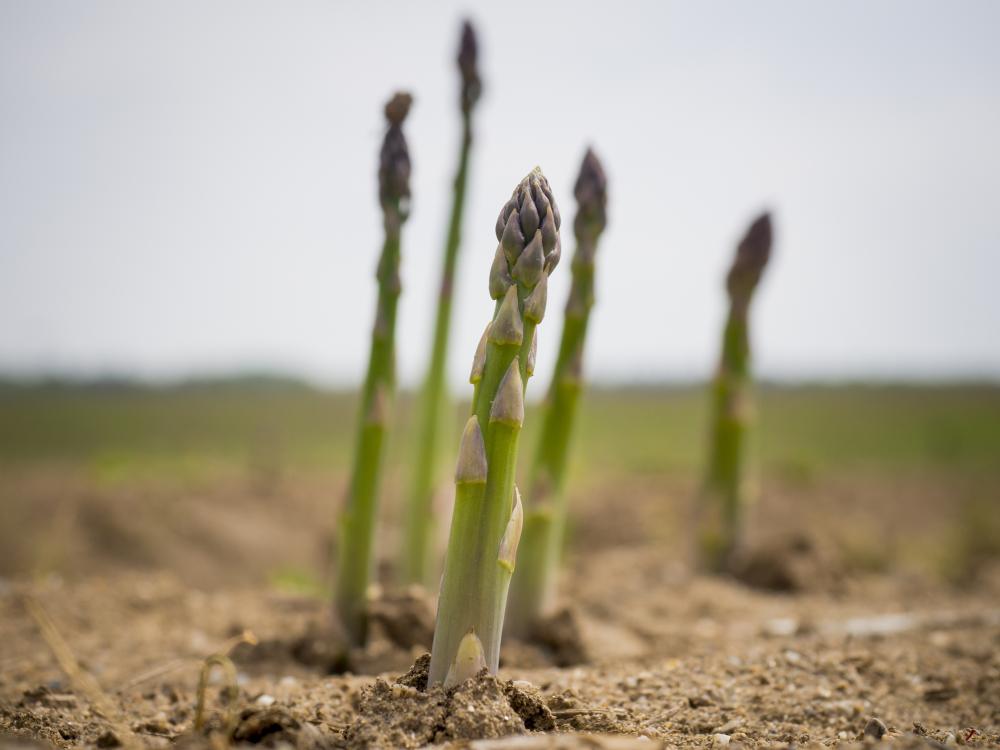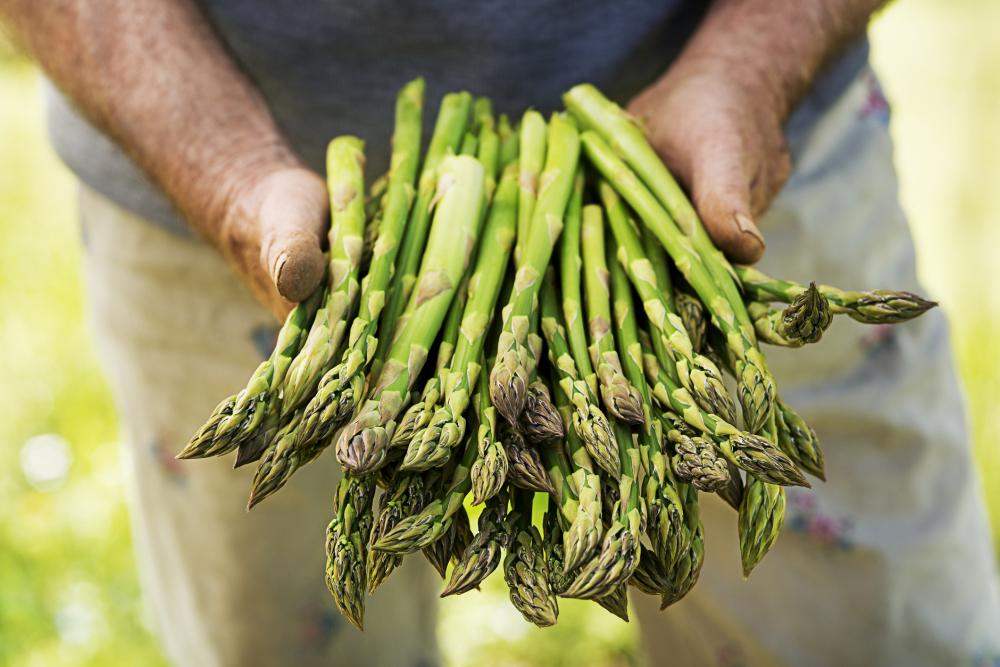Asparagus Care – How To Grow And Harvest Asparagus In The Garden
When you see the first Asparagus shoots emerging, it’s a sure sign that the winter is over and spring is coming. As one of the earliest plants to come out of winter dormancy, the shoots pop out as soon as the soil warms up. The perennial plant stays productive for up to 15 years. This means that your hard work will be rewarded in dividends along the line.
You don’t even have to have a lot of gardening experience to grow asparagus. This hardy perennial is one of the easiest veggies to grow. The whole process is straightforward with no catches or kinks along the way. If you’re just starting with gardening and you had to choose your first plant to grow, I’d recommend asparagus. It’s that easy. The only tricky part is harvesting time. You need to pick your new shoots at the right time or they’ll lose most of their tenderness and flavors. Read on to find out which asparagus variety to plant, how to grow and care for it, and finally when and how to harvest asparagus.
All About Asparagus
Asparagus (Asparagus officinalis) is a perennial vegetable that grows mainly in cooler zones. Although you can grow it in zones 4 to 9, the cooler the climate the better the taste and flavor of the shoots. This explains why the first shoots emerge as soon as the temperature tops 50 degrees F. If you live in warm zones, you’ll notice the veggie emerging out of dormancy even before winter is officially over.
A native of Africa and Europe, the average asparagus grows to about 5 feet tall and 3 feet in width. The stems of the plant are the edible parts that you need to harvest. And while the veggie starts growing edible shoots right away, you shouldn’t harvest those tender stems in the first or second year. This could damage the plant’s structure before it had a chance to establish and develop its root system fully.
To get the most out of your asparagus patch, grow 5 plants for each person. This will provide you with enough harvest to keep your house stocked for months on end. You can cook this delicious and succulent veggie in many ways. I prefer to saute or roast it, but you can also pan-fry, grill, or microwave it. Asparagus is rich in vitamins B and C as well as iron and potassium.
Asparagus Varieties
A trip to the supermarket will reveal just how many asparagus types and varieties there are. The main types are green, white, purple, and wild. Additionally, there are many species and cultivars that fall under each type. That gives you plenty of options to choose from. However, experts recommend that you try out one or more cultivars at a time. Because the veggie is known for its longevity, there’s no need to wait so long to decide whether you like this cultivar or not. So it makes sense to plant up to 3 cultivars at a time. Here are some of the most popular asparagus varieties to consider for your garden.
- Apollo: A green variety with purplish hints. It’s the first variety to grow shoots and has a good yield per plant every season. The stems are thicker than other varieties and have rich and delicious flavors. This variety is more suitable for warm zones since it has a long growing season and you can keep harvesting for months.
- Mary Washington: Nothing says you’re serious about asparagus as growing this cultivar. A very popular variety that has been around for more than a hundred years. The reason for its popularity is that it has nice flavors and a smooth taste. If you’re just starting with asparagus, this is the one cultivar for you. Its shoots can grow to 8 inches and stay tender and succulent.
- Purple Passion: When cooked, this variety loses its purple color although it keeps its wonderful flavor. Grow it in zones 3 to 8. You can also store it and even freeze it for months without losing much of its tenderness and taste.
- Viking KB3: This cultivar is rather new and it is both sturdy and disease-resistant. You can start to harvest it early in the season and it has a high yield.
How to Grow Asparagus
You have two options when it comes to growing asparagus. Either with seeds or crowns. If you’re planning to grow a cultivar, then you should avoid the seeds as a starting option. Most often, the new plants will look nothing like their parents. I recommend starting the veggie from crowns just to be on the safe side here. The best time to plant the vegetable is in the early spring. Soil temperature needs to be above 50 degrees F. for the seeds to germinate.
- If you have a short growing season, you need to start the seeds indoors about 6 weeks before the last frost. Otherwise, you can sow the seeds in the garden directly as soon as the soil is workable.
- Choose a sunny spot in the garden that will be the home for the asparagus for the next 15 years.
- The vegetable needs well-drained and loamy soil. Break the top 10 inches of soil and add three inches of aged manure.
- The soil pH needs to be between 6.5 to 7.4.
- Sow the seeds a quarter-inch deep and space them 2 inches apart. Cover the seeds with soil but don’t firm it. The seeds need air to germinate.
- Water the beds to get the soil moist but not overly wet.
- Wait for the seedlings to grow to 3 inches high before you thin them out leaving 4 inches between the seedlings.
- When male asparagus plants become distinguishable from the females, remove the females since they have a lower yield than the male plants.
Asparagus Care
Although asparagus is a hardy perennial with tolerance for cool temperatures, it is not a very competitive plant, especially when surrounded by weeds. And you’ll need to know the difference between male and female asparagus plants. The flowers on the male plants are larger and brighter. Female flowers will pollinate and produce berries that are resource-intensive. Male asparagus shoots are usually longer and thicker with richer taste than their female counterparts.
Soil
Since we’re talking about a plant that can stay productive for years on end, you’ll need to pay extra care to the soil, not just before you plant the veggie, but also throughout its long life. Turn up the soil a few weeks before you plant the asparagus. If the soil is heavy, amend it with perlite, aged manure, and compost. This will improve the drainage of the soil and add the necessary nutrients for the plant to grow fast.
Don’t forget the soil pH. The soil acidity levels can have a great impact on the flavors and thickness of the asparagus shoots. Don’t get the soil too acidic and get a reading of the pH levels regularly. Anything between 6.5 to 7.0 is good throughout the growing season.
Water
As a perennial veggie, asparagus has different water needs depending on the season and its stage in life. Young asparagus needs about 1 inch of water a week but once it establishes, you’ll need to reduce it to about less than one inch per week. If you live in zones 6 to 9, you might need to increase that weekly quota to 2 inches a week. Hold off watering if you get a decent rainfall and consider it as part of the weekly water quota. As long as you keep the soil moist regularly, you won’t have much trouble.
Once the plant is established by the third year, it will need less watering from you. Cut back the water to one inch a week during the growing season. In the fall and winter, you can get away with watering once every 10 days.
Fertilizer
As usual, perennials tend to deplete the soil of nutrients faster than annuals. And for a plant known for its fast growth rate, asparagus is a heavy feeder. To give your veggie a good start, amend the soil with about 3 inches of aged manure. You’ll do the same every spring just before the first signs of growth emerge. As long as you keep the soil rich, your vegetables will keep producing shoots year after year. You can substitute the aged manure with organic compost.
I wouldn’t recommend using chemical fertilizers since they would stress out the plant and might impact the taste and flavors. Apply the organic fertilizer again after you’re done harvesting.
Overwintering
Overwintering is one of the essential tasks of asparagus care, especially in cooler zones where the winter gets rather cold and there’s a frost threat. If you worry about the frost or frigid winter temperature damaging the vegetable, you’ll need to cut the stems back to one inch above the ground. Don’t worry, they’ll grow back again next spring. The whole idea of winterizing is to protect the root ball of the plant since it’s the most important part of the perennial and essential for its survival. Cover the stems with aged manure to protect them during the winter. For extra protection, add a thick layer of mulch as a cover. This will maintain the soil temperature and stop the roots from freezing over when the temperature drops sharply. You can remove the aged manure and mulch or what’s left of them in the early spring.
Pests and Diseases
Although it’s easy to grow and care for, asparagus has some serious growing problems. The most common pests that attack the vegetable are asparagus beetles. As the name suggests, these beetles favor asparagus vegetables and feed on the young shoots. The bugs hibernate in the soil throughout the winter and appear early in the spring just when the first shoots are emerging. You can pick the beetles with your hand and drown them in a bucket full of soapy water. However, that’s not the end of the story of the beetles. The female insects usually lay their eggs on the stems. When the larvae appear, they feed on the stems of the vegetable and cause a lot of damage. You can use a neem oil spray to get rid of the larvae. Don’t use pesticides otherwise they’ll end up in the food.
The only two diseases to worry about are fusarium wilt and rot. They rarely attack asparagus but just to be safe and avoid future risks, treat the seeds with a diluted bleach solution before planting them. You can also choose disease-resistant varieties such as Viking KB3.
Harvesting Asparagus
The window for harvesting asparagus increases the longer this perennial stays in the soil. For the first couple of years of the plant’s life, don’t harvest the shoots and allow the vegetable to develop a robust structure. By the third year, you can start harvesting the tender shoots as soon as they grow to about 5 inches. You only have a couple of weeks to harvest the shoots.
However, in the fourth year, you have about 5 weeks to harvest the young asparagus shoots. Each subsequent year in the asparagus’ life adds another week of harvesting.


